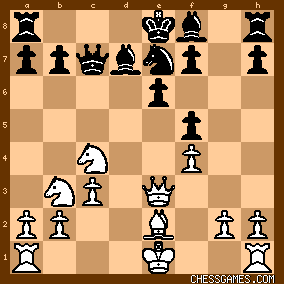KEG: Quite an exciting game to play over.
Some hesitating play by Steiner allowed Kevitz to launch a brilliant and crushing attack, giving up a pieces for two or three pawns and a clear winning position. But then, perhaps because of time pressure, Kevitz missed chances to close out the game quickly, then threw away his winning chances (on move 26) and then blundered away the game entirely (on move 28). Steiner was the happy recipient of this amazing turn of events. Sometimes, just hanging in there does the trick. 1. d4 Nf6
2. Nf3 e6
3. Bg5
A reasonable alternative to the more usual 3. c4. 3... c5
4. e4

click for larger viewAn off-beat line favored first by Marshall and later by Steiner (who played it at least five times including this game). It allows Black a fairly easy equality after 4...cxd4 5. Qxd4 Nc6. Needless to say, Steiner's victory in this game had nothing to do with his choice of opening. 4... Qa5+?!
This move was later adopted--also against Steiner by Reuben Fine (in a game Fine ultimately won) and by Broderman (in a game in which Steiner prevailed). It allows White to get a good game with the simple 5. Qd2. 5. Nbd2
Steiner also played this in his game against Fine. When he played Broderman a year after the Fine game, Steiner improved with 5. Qd2. 5... cxd4
Neither Kevitz here nor Fine in his game against Steiner chose to enter the wild thicket of 5...Nxe4 6. b4 Qxb4 7. Rb1 NxB (Black has another dicey road to equality with 7...Qa5 or 7...Qc3) 8. RxQ NxN+ 9. QxN cxR leaving Black with Rook, Bishop, and two pawns for the sacrificed Queen in a highly unclear position. 6. BxN gxB
7. Nxd4

click for larger viewSteiner had the sounder pawn structure. Kevitz had the two Bishops. An interesting struggle seemed in the making. 7... Nc6
7...f5 was a good alternative.
8. Nb3
Very tentative play by Steiner. 8. NxN; 8 c3; and 8. Nf3 were all better than the text. 8... Qe5
9. c3

click for larger view9... d5
Eager to attack. But 9...f5 as played by Fine against Steiner looks like Black's strongest choice here and yields Black a small edge. 10. Qe2 dxe4
11. Qxe4

click for larger view11... Bd7
With two Bishops and a chance to operate on the open g-file, Black should consider playing an endgame after 11...QxQ+. 11...f5 also was to be considered. 12. f4
Both side seemed keen for a tactical slugfest.
12... Qc7
13. Be2
Preferring not to brave castling long and instead looking to castle short with about even chances. 13... f5
14. Qe3 Ne7
15. Nc4

click for larger viewBeginning here, the fight heated up. | 




